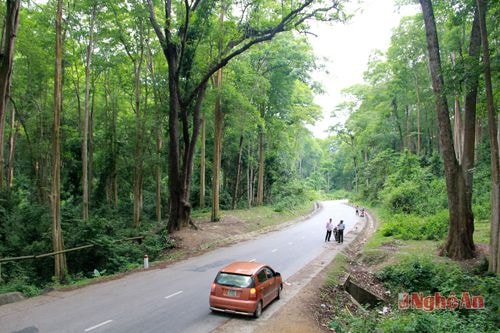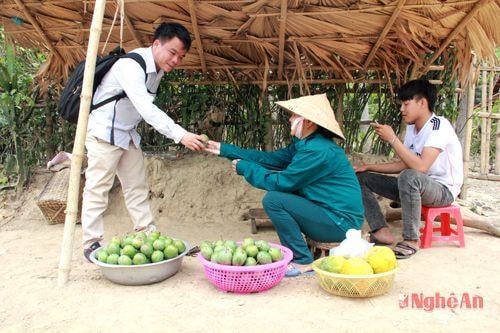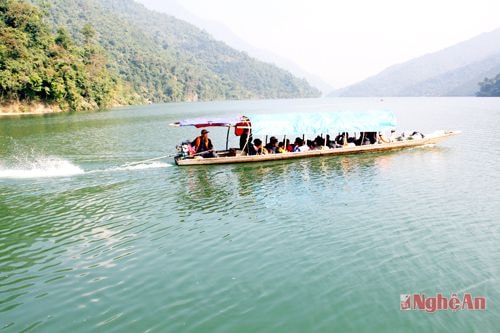A day tour of Xiangyang
(Baonghean) - My friend in Hanoi, through social networks, knew that Nghe An has a beautiful Sang Le forest and wanted to visit it. I took the opportunity to "advertise" that: In addition to the Sang Le forest, there is also Ban Ve hydroelectric lake with clear and cool water and majestic scenery, very suitable for those who love to explore. This land also has a specialty of small but sweet mangoes that are rarely seen.
 |
| Xiangyang Single-celled Forest. |
Hearing me say that, my friend spent the last day, which was also the weekend of his business trip to the Central region, to visit the Western Nghe An region. He was worried that with such limited time, he would not be able to return from Vinh to Tuong Duong in time. But I reassured him: From Vinh City, taking a bus to the districts in the Southwest region is very convenient. From around 3 or 4 am, there are buses running continuously until 7 pm. So I was reassured. I also revealed that if you want to go to Con Cuong and Tuong Duong districts, there are some bus companies that pick up passengers at the address. Just call your mobile phone, at the scheduled time, they will come to pick you up at your place. They are really "illegal" buses but very convenient. The ticket price to Con Cuong district where Pu Mat National Park is located is 70,000 VND, to Tuong Duong district to the casuarina forest is a little more expensive.
Under the canopy of the single tree
From 5am, my friend got on the car from Vinh City. After nearly 3 hours, we met at Con Cuong Town, this mountainous district is famous for the tourist route Ban Nua - Pha Lai Dam - Giang River - Khe Kem Waterfall. However, my friend's destination was Tuong Duong, so we continued straight to the West. My friend wanted to choose the most rustic means of transport, which was a motorbike, although in the center of Con Cuong district there was a self-drive car rental service. I just followed my friend's wishes, but in fact, the cassia forest was located right on National Highway 7, very convenient for car travel.
 |
| People of Cay Me village (Thach Giam - Tuong Duong) sell mangoes next to National Highway 7A. |
Because the services in the tourist destinations in the highlands of Nghe An are still very poor, we had to prepare the necessary necessities quite carefully. After more than an hour, we arrived at Tam Dinh commune (Tuong Duong). This place has a rare and special cajuput forest in the West of Nghe An. Some people compare this primeval forest stretching for more than 1 km along National Highway 7 to a "green paradise". Before the 1960s, it was a cemetery for local people. According to the customs of the indigenous people, the forest is a taboo place, no one dares to touch it. Perhaps because of this spiritual concept, the forest still retains its pristine beauty until the government put it under special management, strictly protected until today. In the harsh midday sun, standing under the forest canopy, the body temperature seems to be regulated. The heat disappears under the green canopy.
The attraction of this small forest is beyond discussion. Yet it seems that all year round there are few visitors here. Perhaps there are only those who stop to enjoy the cool breeze and then get on their motorbikes and drive away. My friend was surprised, because the pristine, fresh beauty of the cajuput forest is hard to match anywhere else, but not many people are interested in it. As if knowing our thoughts, a person in charge of protecting the forest here, Mr. Vi Truong Vinh, resident of Quang Thinh village, shared: Basically, people stop and go because in the middle of the forest there is no restaurant where people can enjoy food and drinks while enjoying the scenery.
Meeting Mr. Vi Vo Tuan, Head of Quang Thinh village, the management area of the casuarina forest, we learned that the scale of this special-use forest is 241 hectares, of which the special forest of casuarina trees is 54 hectares. He pointed to the casuarina trees over 40 meters high and explained: "Currently, we are only assigned the task of protection, but we have only heard about tourism development but have not seen any movement yet."
To ensure security and order and forest fire prevention, the local government only allows drink stalls serving tourists to operate outside the forest. According to our group's observations, Quang Thinh village only has 4 stalls that mainly sell coconut water. The stalls are mostly owned by people who have houses next to the road and some students who come to the village for summer vacation to open services to earn extra income.
Sweet mango land
Going up National Highway 7A through Tam Dinh commune, our group arrived at Tam Thai and Thach Giam communes, the homeland of the Thai community, which is also the "capital" of Tuong Duong sweet mango. Arriving at Cay Me village (Thach Giam), on both sides of the road there were dozens of makeshift leaf shops selling products including vegetables, tubers, and fruits of the highlanders. Over the past few years, life has changed, vegetables from the forest, grown on the fields, and tubers and fruits picked from home gardens have all become goods. My friend chose to stop next to a leaf shop that sold mangoes with a very special green skin. The skin of each mango was covered with a thin layer of ash-colored powder.
I recognized the sweet Tuong Duong mangoes before the young owner warmly invited me. The owner of the shop said the mangoes were almost ripe. If I buy them and leave them for a day or two, they will turn red and fragrant right away. To make the customer believe in the quality of the mangoes, the owner chose a ripe one and cut it open to invite them to try. The sweet taste melted on the tip of the tongue and the fragrance seemed to linger forever. My friend exclaimed: "I have traveled everywhere and found this mango to be the most delicious. It is not inferior to Lai Thieu mangoes from the South. This mango even seems to be more fragrant." I added: "Nghe An people have a saying: Cam Xa Doai, mango Tuong Duong" my friend.
After the guests had enjoyed the food, the owner said: "If you buy a lot, I will sell it for 20,000 VND per kilo, and if you buy retail, it will be 25,000 VND." My friend clicked his tongue: "It's true that the price is a bit higher than some other types of mangoes on the market, but with the sweetness of this specialty, it seems to be... cheap." After buying a large bag of sweet mangoes for 20,000 VND per kilo, we visited the family of Mrs. Xen Thi Lien, a long-time mango grower. She currently has nearly 60 mango trees on both sides of the Lam River. She said that this year's mango crop was bad. Drought made it difficult for the trees to bear fruit, and recently, whirlwinds also caused mangoes to fall in large numbers. However, each mango tree still has about a quintal of fruit.
Offering guests fresh mango with chili, Ms. Lien shared: At first, the family only planted the fruit for their children and grandchildren to eat, then the district government implemented a mango tree development project, so she boldly developed it into a garden. This mango variety is easy to grow, and after only 5 years it will start to bear fruit.
"Touching the gateway" to Ban Ve Lake
Although the sun was high in the sky, my friend still wanted to visit Ban Ve Hydroelectric Lake. After a quick meal of catfish and black chicken, which are not difficult to find in restaurants in Hoa Binh Town, the center of Tuong Duong District, we rode the "iron horse" for about 25 km more to reach Ban Ve Hydroelectric Plant (Yen Na Commune - Tuong Duong).
I secretly felt sorry for my friend because the trip did not coincide with the time when the plant released floodwaters, which would have created a rather majestic landscape instead of the tranquility of a summer afternoon. Not used to going to the mountains, my Hanoi friend had a hard time getting down to the boat dock.
This place has a rather "catchy" name, the Thuong Luu wharf gathers nearly a dozen stalls selling goods of the people, is the place to anchor boats. From a thatched hut, you can see far away. The lake surface is rippling, in the distance are undulating mountains full of mystery. My love for my homeland arose, I talked endlessly about this artificial lake of thousands of hectares. This is originally the basin of the most majestic Nam Non river in Western Nghe An. Currently, this lake is not inferior in beauty and majesty to many hydroelectric lakes in the country. In the middle of the lake, there are many ethnic minority villages, free for you to explore and learn.
 |
| Boats carrying people on Ban Ve hydroelectric lake (Yen Na - Tuong Duong) |
Although it was getting late in the afternoon, my friend still wanted to visit an area on the lake and visit a small village. There were dozens of motorboats anchored there waiting for tourists. They said they were willing to go on "contract" trips if tourists wanted. A boat owner named Thanh Du lived right in Ban Ve, where the hydroelectric plant was being built. After a while of bargaining, we agreed to pay the boat owner 800,000 VND for a quick tour of just a few hours on Ban Ve Lake because tonight my friend had to return to Hanoi to prepare for the new work week. The boat owner said that if we went for a full day, the price for each trip would be 1.8 million VND. If we went for a long day, it would be 1 million VND per day. The boat driver explained that the price of gasoline had increased again, so he had to raise the fare. A few months ago, the price for a day trip was only about 1.5 million VND.
It seemed that my friend did not care much about the price but focused on admiring the scenery of the lake. Every now and then we would see a few mountain peaks rising above the water surface, creating an interesting landscape. "This makes people easily think of the mountains in Ha Long Bay." - My friend shared. After 40 minutes of motorboat ride, we arrived at Pung Ca Moong, a Khmu village in Luong Minh commune (Tuong Duong). This visit to the resettlement village in the Ban Ve Hydropower Reservoir, although only lasted for more than an hour, left my friend from the North with a feeling of regret: If only I had more time.
Because of his busy work, my friend did not have time to stay overnight in the mountainous town of Hoa Binh. However, he had a delicious dinner with dishes made from wild vegetables, which according to the doctor's advice for him and overweight people, was a beneficial menu.
At 8 pm, my friend got on the bus to return to Hanoi. Before saying goodbye, he had time to share: Everything here is interesting, but it seems that the locality has not yet exploited the potential to develop tourism. When he shared these concerns with Mr. Vi Sat Son, Head of the Department of Culture, Sports and Tourism of Tuong Duong district, he confided: "Everything is just in its infancy, sir. At the Ban Ve Hydropower Reservoir, there is now a Dong Tam Cooperative building a model to serve tourists. The people working in the Cooperative are mainly officials of the District People's Committee so that people can follow suit."
So to awaken the tourism potential in Tuong Duong district in particular, and the whole Western Nghe An region in general, there is still much work to do...
You Wei






